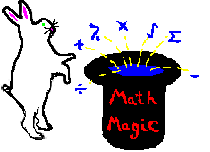

A. This method is very easy since from algebra we know:
a + b = 2 + (b a)2 *Note: Since you are squaring (b a) it does
b
a
ab not matter if you use (b a)2 or (a b)2.
B. Use the following steps:
1. Find the difference between the two numbers, b and a.
2. Square the result of step 1. This is the numerator.
3. Multiply the two numbers, b and a. This is the denominator.
If the fraction is proper, write down 2. This is the whole number.
If the fraction is improper, fix it to be a mixed number and add it to 2 for the answer (see Ex [2] below).
Ex [1] 3 + 5 =
5 3 (mixed number).
a) (5 3)2 = 4. This is the numerator.
b) 5 x 3 = 15. This is the denominator.
c) Since 4/15 is a proper fraction, write 2 for the whole number.
d) The answer is 2 4/15.
Ex [2] 2 + 7 =
7 2 (mixed number).
a) (7 2)2 = 25. This is the numerator.
b) 7 x 2 = 14. This is the denominator.
c) Since 25/14 is an improper fraction, we need to "fix" it to be 1 11/14.
d) Now we add this to 2 to get 3 11/14.
e) The answer is 3 11/14.